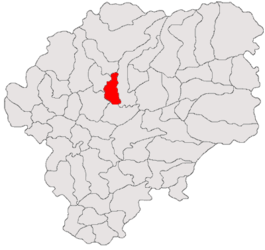Năsăud
Năsăud | |
|---|---|
 Năsăud town hall | |
 Location in Bistrița-Năsăud County | |
| Coordinates: 47°17′0″N 24°24′24″E / 47.28333°N 24.40667°E | |
| Country | Romania |
| County | Bistrița-Năsăud |
| Government | |
| • Mayor (2020–2024) | Dorin-Nicolae Vlașin[1] (PNL) |
| Area | 43.25 km2 (16.70 sq mi) |
| Elevation | 330 m (1,080 ft) |
| Population (2021-12-01)[2] | 10,215 |
| • Density | 240/km2 (610/sq mi) |
| Time zone | EET/EEST (UTC+2/+3) |
| Postal code | 425200 |
| Vehicle reg. | BN |
| Website | www |
Năsăud (Romanian pronunciation: [nəsəˈud]; German: Nassod, Nußdorf; Hungarian: Naszód) is a town in Bistrița-Năsăud County in Romania located in the historical region of Transylvania. The town administers two villages, Liviu Rebreanu (until 1958 Prislop; Priszlop) and Lușca (Szamospart).
Geography
The town lies on the Transylvanian Plateau, on the right bank of the Someșul Mare River. It is located in the central part of the county, at a distance of 24 km (15 mi) from the county seat, Bistrița, and 30 km (19 mi) from the town of Beclean.
History
The name Năsăud is possibly derived from the Slavic nas voda, meaning "near the water" or "our water". Another etymology is from Nußdorf (Nussdorf, "walnut tree village"), the Transylvanian Saxon name of the town during the Middle Ages.
A former Habsburg border town known for its border regiments with panache and good schools, Năsăud was the stage for the assembly of 10 September 1848, when the Austrian commander Karl von Urban summoned hundreds of leaders of all 44 districts of the Principality of Transylvania to the town and proclaimed resistance against the Revolution of 1848 and the annexation of Transylvania by Hungary.[3]
Năsăud saw industrial expansion during the communist era and industrial collapse after the Romanian Revolution of 1989.
Năsăud still has a few late 18th and early 19th century buildings left standing. Most remarkable in this regard is the local Romanian Greek Catholic church and the former military headquarters of the Habsburg era military regiment, now a museum. Although the town hall is located in its midst, the 19th century center of the town has been left to decay. Since 2012 the municipality has begun to restore the buildings in the old city center. The town hall saw a complete restoration and expansion in 2013.
Demographics
| Year | Pop. | ±% |
|---|---|---|
| 1930 | 3,512 | — |
| 1948 | 3,716 | +5.8% |
| 1956 | 5,725 | +54.1% |
| 1966 | 6,620 | +15.6% |
| 1977 | 8,610 | +30.1% |
| 1992 | 12,176 | +41.4% |
| 2002 | 11,365 | −6.7% |
| 2011 | 9,077 | −20.1% |
| 2021 | 10,215 | +12.5% |
| Source: Census data | ||
At the 2021 census, Năsăud had a population of 10,215.[4] At the 2011 census, 93.6% of inhabitants were Romanians, 5.5% Roma, and 0.6% Hungarians.
Economy
Local economic activity revolves around the remittance economy generated by massive outmigration to Spain and Italy during the early 2000s, although the largest industrial employers in textiles and chemicals have been rejuvenated by European Union membership.
The economic upturn of the mid-2000s has translated into a better city life and infrastructure improvements. Most notable in this regard are the refurbishing of the old military headquarters (now a museum), improved roads and more bar/restaurant options.
Education
The town is the home of the George Coșbuc National College.[5]
Natives
- Tudor Bompa (born 1932), sports scientist, professor at York University
- Joel Brand (1906–1964), member of the Budapest Aid and Rescue Committee during the Holocaust
- Nicolae Bretan (1887–1968), opera composer, baritone, conductor, and music critic
- Vasile Dîncu (born 1961), politician
- Tudor Drăganu (1912–2010), jurist
- Sergiu Homei (born 1987), footballer
- Veronica Micle (1850–1889), poet, best known for her love affair with Mihai Eminescu
- Constantin C. Moisil (1876–1958), archivist, historian, numismatist, and schoolteacher
- Iuliu Moisil (1859–1947), schoolteacher and non-fiction writer
- Sandu Negrean (born 1974), footballer
- Ovidiu Nimigean (born 1962), writer
- Leonida Pop (1831–1908), officer in the Austrian Imperial Army
Photo gallery
-
Entrance from the west
-
View from the east
-
Train station
-
Towers of the Romanian Greek-Catholic church
-
Monument in the park
-
Romanian Orthodox church
Notes
- ^ "Results of the 2020 local elections". Central Electoral Bureau. Retrieved 6 June 2021.
- ^ "Populaţia rezidentă după grupa de vârstă, pe județe și municipii, orașe, comune, la 1 decembrie 2021" (XLS). National Institute of Statistics.
- ^ Miskolczy, Ambrus (2002). Transylvania in the Revolution and the War of Independence (1848-1849) in History of Transylvania Vol. III. Institute of History of the Hungarian Academy of Science. ISBN 0-88033-497-5.
- ^ "Populația rezidentă după grupa de vârstă, pe județe și municipii, orașe, comune, la 1 decembrie 2021" (in Romanian). INSSE. 31 May 2023.
- ^ "Colegiul Național "George Coșbuc" Năsăud". www.gcosbucnasaud.ro (in Romanian). Retrieved November 24, 2021.









